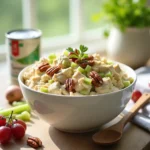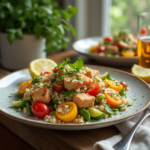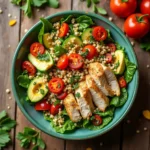Introduction
Gluten free dinner recipes opened a new world of culinary creativity for me. I remember the first time I discovered the magic of gluten free cooking. It was a chilly autumn evening, and I was hosting a small dinner for my closest friends. One of them had recently been diagnosed with a gluten sensitivity, so I was determined to prepare a meal that was both comforting and safe for everyone.
In my kitchen, the usual rush was replaced by a calm focus as I gathered fresh vegetables, gluten free grains, and a blend of aromatic herbs. I recalled childhood memories of cooking with my grandmother, who always stressed the value of using quality ingredients and simple methods. That night, I set out to blend cherished traditions with a modern twist, creating dishes that would bring both nourishment and delight to my guests.
As the aromas began to fill the house, excitement grew among my friends. The table soon featured a colorful spread: a hearty gluten free pasta salad bursting with cherry tomatoes and basil, a crisp green salad lightly dressed in a tangy vinaigrette, and a warm vegetable stew that felt like a comforting hug. Each dish was a unique blend of personal memories and culinary experimentation.
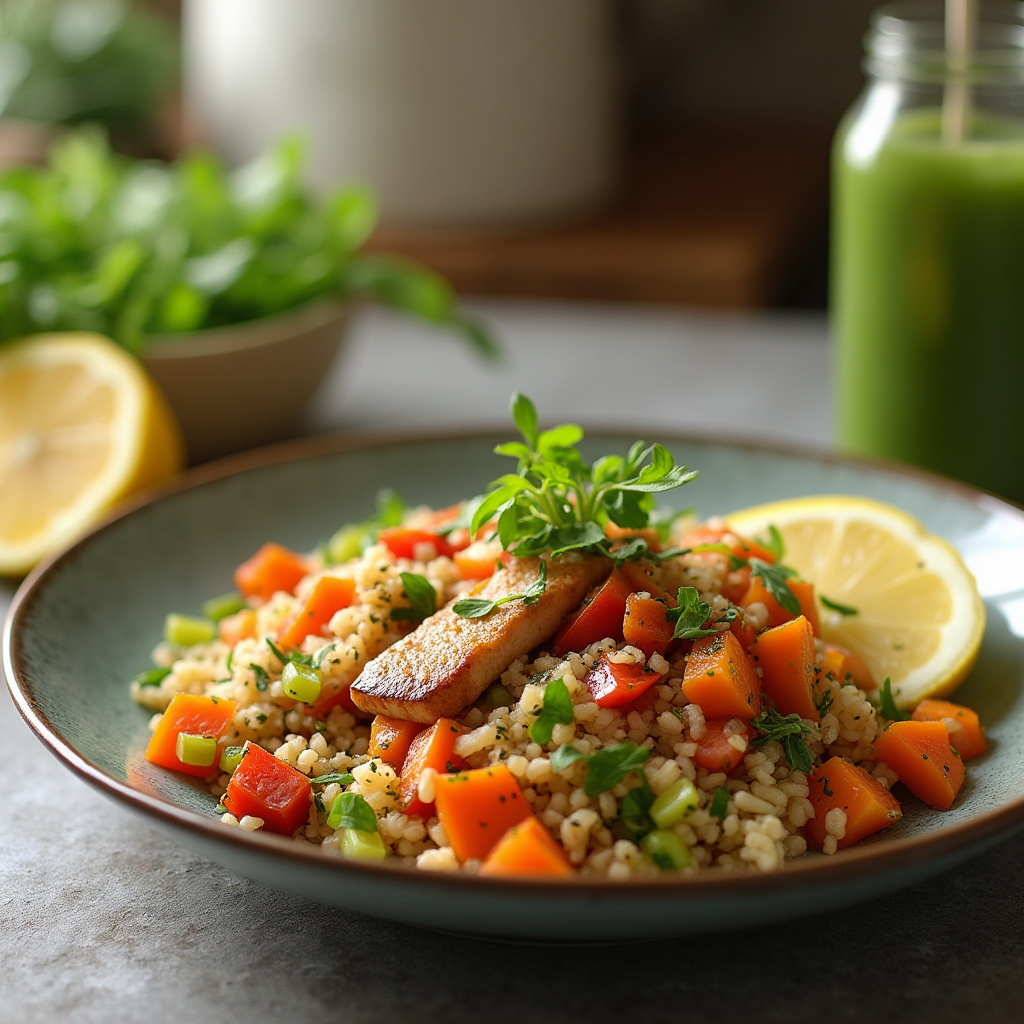
When everyone sat down to enjoy the meal, the atmosphere was filled with smiles and genuine appreciation. That evening, I discovered that gluten free dinner recipes were more than just a dietary choice—they were a celebration of inclusivity and the joy of discovering new flavors. I learned that even everyday ingredients could be transformed into something truly extraordinary with a little creativity and passion.
This memorable experience marked the beginning of my journey into gluten free cooking. It taught me that, with the right approach, even the most challenging dietary restrictions can lead to a delightful culinary adventure. Now, I’m excited to share these recipes with you, hoping they bring as much joy and warmth to your table as that special evening did to mine.
Table of Contents
Key Benefits
Gluten free dinner recipes offer many benefits that make them a smart choice for everyday cooking. They support healthier digestion, add variety to your meals, and provide inclusive options for all your guests.
- Improved Digestion: Many people find that removing gluten helps ease stomach discomfort. A lighter meal can boost energy and overall well-being.
- Fresh Variety: Gluten free cooking opens the door to new ingredients and flavors. It encourages you to explore diverse vegetables, grains, and herbs that you might not use otherwise.
- Healthier Options: Many gluten free recipes feature whole foods and fresh produce. These meals naturally pack vitamins and minerals essential for daily nutrition.
- Inclusive Dining: These recipes cater to those with gluten sensitivities or celiac disease. They allow you to host dinners that accommodate all dietary needs.
- Simple Preparation: Gluten free dinner recipes are often designed with quick, straightforward steps. This makes it easier to prepare a wholesome meal even on busy weeknights.
By choosing gluten free dinner recipes, you can enjoy meals that are not only flavorful but also supportive of a balanced, healthy lifestyle.
Ingredients
Below is a detailed list of ingredients that you can use for a variety of gluten free dinner recipes. Each item has been selected to ensure flavor, nutrition, and versatility. You can mix and match these components to create dishes that are both hearty and naturally gluten free.
Core Ingredients
- Gluten Free Grains:
- Quinoa
- Brown rice
- Buckwheat
- Gluten free pasta
- Millet
- Fresh Vegetables:
- Spinach
- Kale
- Bell peppers
- Cherry tomatoes
- Zucchini
- Carrots
- Proteins:
- Chicken breast or thighs
- Lean beef or turkey
- Tofu or tempeh (for a plant-based option)
- Fish (such as salmon or cod)
- Legumes:
- Lentils
- Chickpeas
- Black beans
- Healthy Fats:
- Olive oil
- Avocado oil
- Nuts and seeds (almonds, walnuts, chia seeds)
Pantry Staples
- Gluten Free Flours:
- Almond flour
- Rice flour
- Tapioca starch
- Sorghum flour
- Herbs and Spices:
- Basil
- Oregano
- Thyme
- Rosemary
- Turmeric
- Black pepper
- Sea salt
- Broths and Sauces:
- Gluten free vegetable or chicken broth
- Tomato paste
- Gluten free soy sauce or tamari
- Mustard
Optional Enhancements
- Dairy or Dairy Alternatives:
- Fresh mozzarella or cheddar (if dairy is suitable)
- Unsweetened almond or coconut milk
- Greek yogurt (check for gluten-free labeling)
- Acidic Components:
- Lemon juice
- Apple cider vinegar
- Sweeteners:
- Honey
- Maple syrup
This ingredients list is designed to cover a wide range of gluten free dinner recipes, from quick weeknight meals to dishes that are perfect for entertaining. By using naturally gluten free grains, lean proteins, and a variety of fresh vegetables, you can build balanced, tasty, and nutritious meals that meet dietary needs without sacrificing flavor. Feel free to adjust the ingredients based on what’s in season or available in your local market.
Instructions
Follow these step-by-step instructions to create your gluten free dinner masterpiece. Each step is designed to be clear and easy to follow, ensuring that you achieve a delicious and satisfying meal.
Step 1: Prepare Your Workspace
- Gather Your Ingredients: Begin by assembling all the core ingredients, pantry staples, and any optional enhancements you plan to use.
- Organize Your Tools: Ensure you have the necessary cooking utensils, cutting boards, knives, pots, pans, and a baking dish if you plan to bake your dish.
- Clean Your Workspace: Make sure your kitchen area is clean and ready for a smooth cooking process.
Step 2: Preheat and Set Up
- Preheat the Oven: If your recipe requires baking, preheat your oven to 375°F (190°C). This step is essential for even cooking and optimal texture.
- Prepare Cooking Stations: Set up separate areas for chopping vegetables, cooking grains, and handling proteins. This organization helps streamline your workflow.
Step 3: Prepare the Ingredients
- Wash and Chop Vegetables: Rinse all fresh vegetables thoroughly. Dice, slice, or julienne them according to the recipe’s requirements. For example, chop bell peppers, zucchini, and carrots into bite-sized pieces.
- Season Proteins: If using chicken, tofu, or another protein, season lightly with salt, pepper, and herbs such as thyme or rosemary. This ensures even flavor distribution during cooking.
- Measure Dry Ingredients: Accurately measure your gluten free grains and flours. Whether you are using quinoa, rice, or buckwheat, correct proportions help maintain the dish’s balance.
Step 4: Cooking the Components
- Cooking Gluten Free Grains:
- Rinse the grains under cool water.
- In a medium saucepan, add the grains and an appropriate amount of water or gluten free broth.
- Bring the mixture to a boil, then reduce the heat and let it simmer until the grains are tender. This typically takes about 15–20 minutes for quinoa or rice.
- After cooking, gently separate the grains with a fork and set them aside.
- Sautéing Vegetables:
- Warm a small amount of olive oil in a large skillet on medium heat.
- Add the chopped vegetables, starting with those that take longer to cook, such as carrots and zucchini.
- Sauté for 5–7 minutes until the vegetables become tender yet retain a slight crunch.
- Season lightly with salt, pepper, and your chosen herbs.
- Cooking the Protein:
- If using chicken, heat a separate pan over medium-high heat and add a small amount of oil.
- Sauté the chicken pieces for approximately 5–6 minutes per side until they turn golden and are completely cooked.
- For tofu or tempeh, pan-fry until each side is crisp and lightly browned.
- Remove the protein from the heat and let it rest before slicing it into bite-sized portions.
Step 5: Combining Components
- Layering Flavors:
- In a large mixing bowl, combine the cooked grains, sautéed vegetables, and protein.
- Add any additional ingredients such as legumes or a handful of fresh greens.
- Drizzle in your preferred gluten free sauce or broth, and mix gently to ensure all components are evenly distributed.
- Taste the mixture and adjust the seasoning if necessary, adding extra salt, pepper, or herbs.
- Optional Baking Step:
- Place the mixture into a lightly oiled baking dish.
- Top with a sprinkle of gluten free cheese or a light layer of your favorite gluten free bread crumbs for a crunchy finish.
- Bake in the preheated oven for 15–20 minutes until the dish is heated through and the top is lightly golden.
Step 6: Final Touches and Presentation
- Resting the Dish: If you baked the dish, allow it to rest for 5 minutes after removing it from the oven. This allows the flavors to blend together, making the dish easier to serve.
- Garnish: Before serving, consider garnishing with a squeeze of lemon juice, a sprinkle of fresh basil, or a dash of extra virgin olive oil. These finishing touches can enhance both flavor and visual appeal.
- Serving: Scoop the dish into individual serving bowls or plates. Pair your gluten free dinner with a side salad or a light soup to round out the meal.
These instructions guide you through each stage of creating a gluten free dinner that is both flavorful and balanced. The process emphasizes simplicity and clear, direct steps, ensuring that whether you are an experienced cook or a beginner, you can achieve a delicious result every time.
Pro Tips and Variations
Enhance your gluten free dinner with these pro tips and variations designed to make your cooking experience even more enjoyable and personalized.
Pro Tips
- Plan Ahead:
Prepare your ingredients in advance. Pre-chopped vegetables, pre-measured grains, and marinated proteins can reduce cooking time, especially on busy weeknights. - Season Wisely:
Experiment with different herbs and spices. A dash of smoked paprika or a pinch of cumin can elevate the flavor profile without overpowering the natural taste of your ingredients. - Maintain Texture:
For an appealing contrast, consider pairing crunchy elements with softer components. For example, lightly toasted gluten free breadcrumbs or chopped nuts can add a pleasant crunch to a tender vegetable stew. - Monitor Cooking Times:
Gluten free grains and flours can sometimes cook differently from their gluten-containing counterparts. Keep an eye on your cooking times and adjust as necessary to avoid overcooking. - Stay Flexible:
Adapt recipes based on what’s in season or available in your pantry. This flexibility allows you to explore a variety of flavors while keeping the dish balanced and fresh.
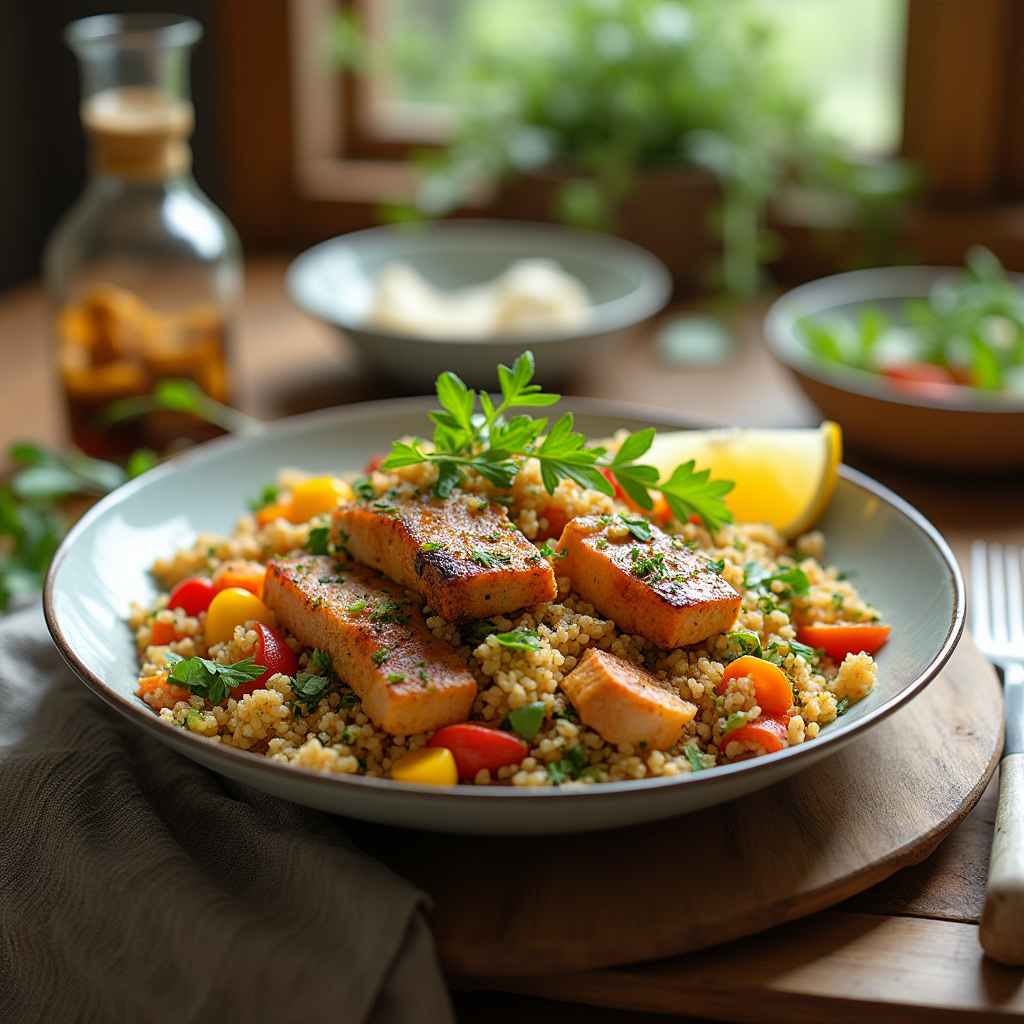
Variations
- Vegetarian or Vegan Twist:
Replace animal proteins with plant-based alternatives such as tofu, tempeh, or extra legumes. Use dairy-free alternatives like almond or coconut milk in sauces and dressings. - Spicy Kick:
Add a hint of heat by incorporating red pepper flakes, a dash of hot sauce, or even a fresh chili pepper. This variation works well in vegetable sautés and hearty grain bowls. - Herbal Infusion:
Experiment with fresh herbs like cilantro, mint, or dill. Add these towards the end of cooking or as a garnish to maintain their vibrant flavor and color. - Baked Upgrade:
For a comforting casserole version, layer your components in a baking dish, top with gluten free cheese or breadcrumbs, and bake until the flavors meld together. This method creates a crispy top while keeping the inside moist and flavorful. - Quick Stir-Fry Option:
Use the same base ingredients to create a stir-fry. Cook the proteins and vegetables in a hot pan with a splash of gluten free soy sauce or tamari. Serve over cooked quinoa or rice for a fast, nutritious meal. - Sauce Variations:
Consider preparing a few different sauces to pair with your dish. A light lemon vinaigrette, a creamy dairy-free sauce, or a tangy tomato-based sauce can provide distinct flavor profiles that complement various ingredients.
These pro tips and variations allow you to tailor your gluten free dinner to suit your taste, dietary needs, and time constraints. They encourage creativity in the kitchen, ensuring that every meal can be a unique and satisfying experience while maintaining a balanced, nutritious profile. Enjoy experimenting with different combinations to discover what works best for your palate and lifestyle.
Serving Suggestions
When it comes to presenting your gluten free dinner, the way you serve your dish can enhance both its appeal and flavor. Here are some ideas to consider when plating your meal:
- Balanced Plate:
Arrange a portion of your main dish alongside a fresh salad or lightly steamed vegetables. This combination creates a balanced plate that is not only colorful but also provides a mix of textures and flavors. - Garnish for Freshness:
A simple garnish can transform the look of your dish. Consider a sprinkle of chopped fresh herbs such as basil or cilantro, a few lemon wedges on the side, or a drizzle of a gluten free dressing to add a burst of flavor right before serving. - Side Dishes:
Complement your dinner with side dishes that add variety to your meal. Options like a light soup, a quinoa salad, or a serving of roasted root vegetables work well. If you enjoy a crunchy element, gluten free bread or a crisp rice cake can be a delightful addition. - Family-Style Presentation:
For a more communal dining experience, serve the dish in a large bowl or on a platter that allows everyone to help themselves. This approach works particularly well for casual family dinners or friendly gatherings, encouraging conversation and sharing. - Elegant Plating:
For a more refined look, arrange the components on each plate with care. Place the protein in the center, with the grains and vegetables artistically arranged around it. A light drizzle of sauce across the plate not only adds flavor but also enhances visual appeal. - Personal Touch:
Feel free to add your own creative twist. Whether it’s a sprinkle of gluten free seeds for extra crunch or a side of seasonal fruit for a refreshing contrast, these small additions can elevate the overall dining experience.
These serving suggestions aim to make your gluten free dinner not only nutritious but also visually enticing, ensuring every meal is a feast for both the eyes and the palate.
Conclusion
In summary, this guide offers a clear path to creating gluten free dinner recipes that are both flavorful and nourishing. We have outlined the key benefits of gluten free cooking, provided a comprehensive list of ingredients, and shared step-by-step instructions to help you build a delicious meal. Each section is crafted to empower you to experiment and find joy in preparing meals that cater to a variety of dietary needs.
These recipes emphasize simplicity and versatility. Whether you are cooking for yourself or hosting a family dinner, you have the flexibility to adjust ingredients, experiment with different flavors, and serve a balanced dish. The pro tips and variations encourage you to personalize your cooking process, ensuring that every meal is both unique and satisfying.
The journey through this guide is more than just following a recipe—it is about embracing a healthier lifestyle and enjoying the art of cooking. By integrating fresh ingredients, healthy grains, and creative techniques, you can create a dinner that not only meets gluten free requirements but also delights the senses.
We hope that this guide inspires you to try new combinations and share the joy of gluten free cooking with those around you. Enjoy your culinary adventure and the tasty magic that gluten free recipes can bring to your table. For food safety guidelines, refer to the U.S. Food Safety and Inspection Service: https://www.fsis.usda.gov/food-safety
FAQs
What are the worst foods for gluten?
Foods high in gluten are usually made with wheat, barley, or rye. Common examples include traditional bread, pasta, most cereals, and many baked goods. Processed foods like some sauces, soups, and snacks may also contain gluten as a thickener or stabilizer. It’s best to read labels carefully if you’re avoiding gluten.
Are rice krispies gluten-free?
Traditional Rice Krispies are made from rice and are generally gluten-free. However, cross-contamination can sometimes occur during processing, and some versions might include additional ingredients that contain gluten. Always check the packaging for any gluten-related warnings to be sure.
Are potato chips gluten-free?
Many plain potato chips are naturally gluten-free since they are made primarily from potatoes. That said, flavored varieties can include gluten-containing additives or be processed in facilities that also handle gluten products. Reading the ingredient list and allergen information on the packaging is key.
What junk food doesn’t have gluten?
There are several gluten-free junk food options available. Look for snacks like certain brands of popcorn, plain potato chips, and corn-based products. However, many processed snacks have hidden sources of gluten. Always review the label to ensure the product meets gluten-free standards.


